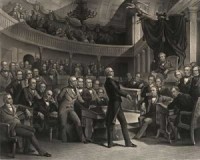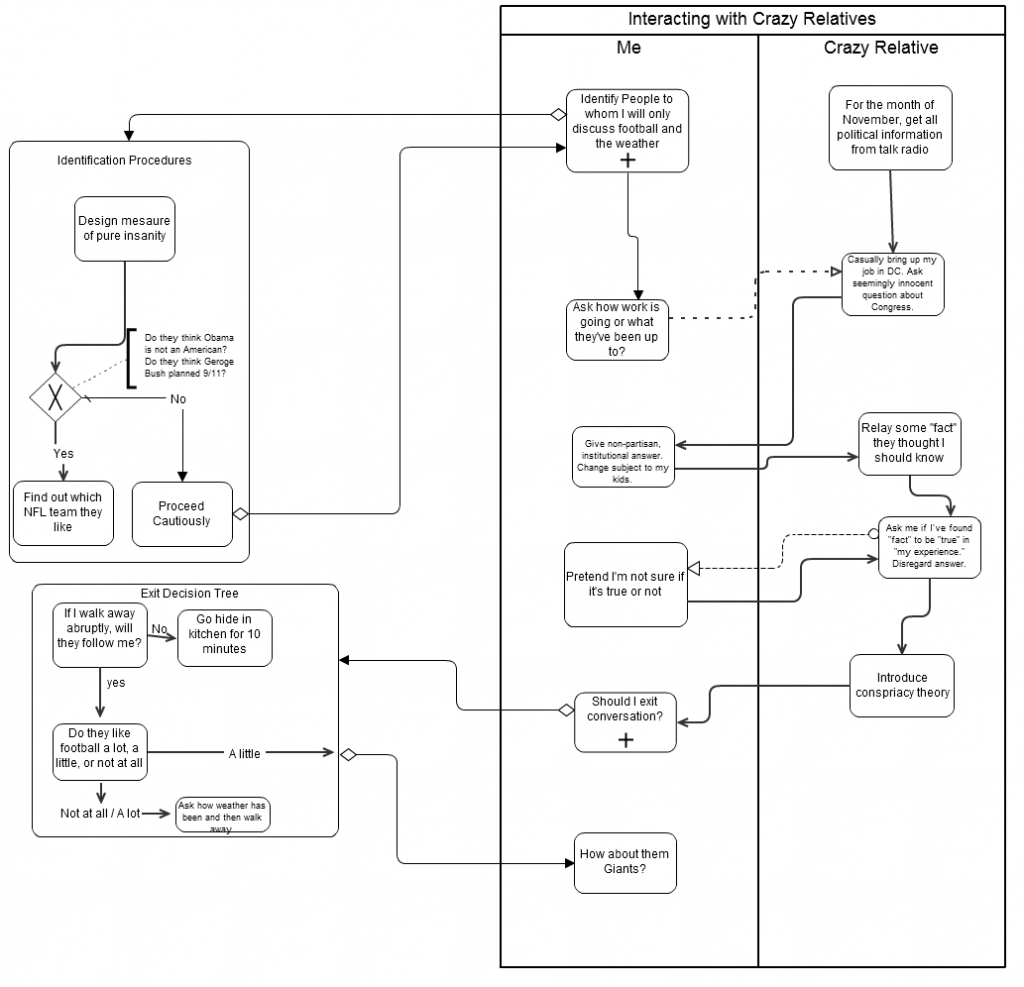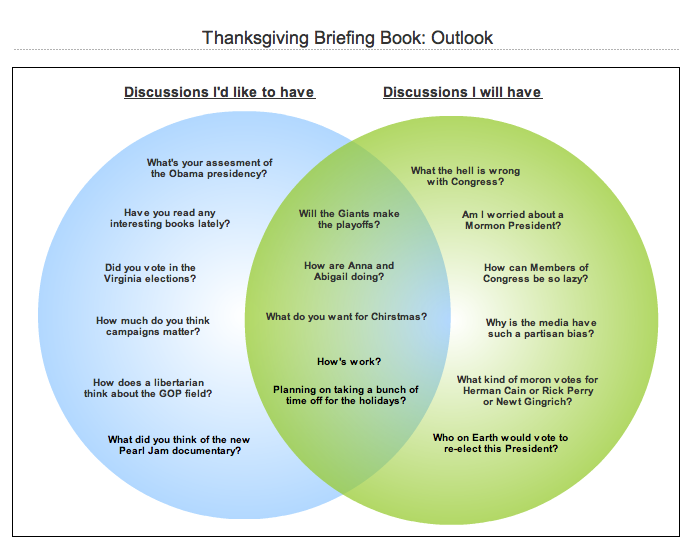 A few months ago, I put up a post with a long list of Hill jargon in response to a short-but- good published article (subscription required). Since my original post was pretty well received, here’s an updated version with another three dozen terms. As with the first installment, this isn’t formal terminology related to floor procedure, that can be found in quite a few places. This is the language that staffers use. Like any profession, the Hill is chock-full of wonderful phrases and sayings. But unlike a lot of other professions, politics tends garner a lot of interest from non-practitioners. So enjoy. These are off the top of my head. So feel free to add on in the comments.
A few months ago, I put up a post with a long list of Hill jargon in response to a short-but- good published article (subscription required). Since my original post was pretty well received, here’s an updated version with another three dozen terms. As with the first installment, this isn’t formal terminology related to floor procedure, that can be found in quite a few places. This is the language that staffers use. Like any profession, the Hill is chock-full of wonderful phrases and sayings. But unlike a lot of other professions, politics tends garner a lot of interest from non-practitioners. So enjoy. These are off the top of my head. So feel free to add on in the comments.
BTU (or BTU’d): When backbench majority House Members cast a tough vote to support the leadership, but then the policy never even materializes because the Senate doesn’t take up the bill. Named after a vote in 1993, in which House Democrats cast a painful vote to raise taxes on home heating oil and other energy, measured in BTU’s, only to see the Senate never even take up the bill. Usage: I hope to god we don’t get BTU’d on this health care vote. It was bad enough on the climate change bill.
Rolled: When a faction of a party or group gets end-run or otherwise outmaneuvered politically. Usage: I can already see what’s going to happen here: the liberals are going to get rolled again by a conservative coalition.
Apoplectic: When a Member or staff gets enraged by new information or news. Usage: When he found out the minority was going to move 30 amendments, the Chairman was apoplectic.
Recommend: Polite language staffers often use to tell their bosses what they should do. Usage: On the tax amendment, I recommend you vote no.
Ping-pong: Reconciling the differences between a House-passed bill and a Senate-passed bill by amendments between the chambers, rather than forming a conference committee. More common now than in the past. Usage: I don’t think they have the time or inclination to put a conference together on the omnibus, we’ll probably just ping-pong it.
Mr./Ms.: The title staffers use for Members other than “their boss.” Usage: Is everyone in the hearing room? No, we’re still waiting on Mr. Obey and Mr. Skelton.
Camel’s nose: The principle that once funding starts — no matter how little — for a project, it will be difficult to cut and probably grow larger. Usage: But they only want $250,000 for it. Yeah, but that’s just the camel’s nose.
Justifications: Short for budget justifications, documents submitted by agencies to the appropriations committee outlining their budget requests for the following fiscal year. Usage: What the hell is this $2 million for “additional overages”? I don’t know, check the justifications.
Push-back: When a stakeholder objects to draft or proposed legislation coming out of a Member’s office or a committee. Usage: We thought it would work to structure it that way too, but we got a lot of push-back from the auto industry.
Stakeholder: An interest group or other entity that has a position on a piece of legislation. Usage: This bill is a nightmare. There are a million stakeholders,and they all want something different!
Pen and Pad: A type of press availability held by Members on the Hill at which video/photography is not allowed, usually associated with leadership Members who often hold them on a weekly basis at a scheduled time. Named as such because the reporters all used to gather around the Member with their pads of paper and pens. Now many just put a tape recorder on the table. Usage: Are you going to Hoyer’s pen and pad tomorrow?
Build a public record: The main reason for holding a hearing, which is to get the committee majority’s position and rationale for a bill down on paper. Usage: The boss wants it to move by Christmas. So we need to build a public record on this thing. I guess we should schedule a hearing.
MRA: Short for Members Representational Allowance. The money that each House office is given to fund staff salaries, travel, office expenses and franked mail. Senate equivalent is the SOPOEA (Senator’s Official Personnel and Office Expense Account). Usage: Can drinks at Bullfeather’s be charged to the MRA if we talk about politics?
Face Time: One-on-one interactions between a staffer and the Member he/she works for. Usage: How’s your new job on the Hill? It’s great, but my boss is so busy that I’m lucky to get 30 minutes of face time a week.
D.O.: District Office. Virtually all Members employ staffers to work in their home districts, usually to handle casework and constituent outreach. Usage: What the intake procedure for these constituent passport questions? I have no idea, call the DO.
Move: To advance legislative action on a bill, either in committee or on the floor. Usage: Any word on when the defense reauthorization is going to move? Nope. But they’re moving the minibus on Thursday, so I think it might happen next week.
D-Trip: Short for D-Triple-C, which is slang for DCCC, which is the acronym for the Democratic Congressional Campaign Committee, which is the primary campaign arm of the House Democrats. Republican equivalent is the NRCC; Senate equivalents are the DSCC and NRSC. Usage: Did Chris get that job with Smith? No, but he landed a sweet position at the D-Trip.
Christmas Tree / too many ornaments: Refers to the process of too many amendments/ideas being added to a bill, causing opposition to grow. Interchangeable with “collapsed under its own weight.” Usage: I thought the omnibus had a chance, but now there are too many ornaments weighing down the Christmas tree.
Subcommittee print: A document produced by subcommittee staff for Members and other staff, often related to a bill. Usually never made public, but often a great source of information. Usage: How much money did that agency get in FY08? I have no idea, check the subcommittee print.
FTE: Acronym for “full-time equivalent,” which is the standard metric for number of employees in an executive branch agency. Usage:Did you see the budget justifications the agency sent over? They’re asking for 45 new FTEs!
Report language: Instructions, observations, and expectations found in the committee report that accompanies a bill to the floor. Does not have the force of law (as “bill language” does), but agencies ignore it at their own risk. Usage: Call them back and tell them we’re serious about the unauthorized travel. And if they don’t want to listen, tell them we’ll add some stern report language to the reauthorization. And if they still don’t want to listen, we’ll just put it in bill language.
Budget drills: In the early stages of appropriations season, prior to the passage of a budget resolution and 302(b) suballocations, appropriations staffers will often produce hypothetical appropriation bill estimates at various percentages of the previous year’s allocation. Usage: What have you been up to? Just some light budget drills — we look good at 2% over FY11, but anything less is going to be tough.
Test vote: A procedural or other non-final vote, almost always in the Senate, that gives a signal as to where different Members stand on the underlying issue, and thus a roadmap as to how a bill might or might not have to change to win support. Usage: I don’t know where we stand on the debt deal, but they’ve lined up a couple test votes this afternoon, so we’ll know then.
Marker: A piece of legislation intended not to make law, but to lay down a position, for either political or negotiation purposes, or both. Often the introduction of a bill or a proposed amendment. Usage: The details of the legislative language don’t have to be perfect, we’re just laying down a marker.
Byrd bath: A review of legislative language prior to floor action under the reconciliation process to make sure that it conforms to the Byrd Rule, which bars certain extraneous legislation in reconciliation bills. Usage: When do you think they are going to move the reconciliation package? I know that they are doing the Byrd bath on Tuesday night, so probably by the end of the week.
Take down / bring down: When the majority is defeated on the floor in the House, which by definition involves Members of the majority voting against the leadership. Usage: The blue dogs are pretty upset right now, but I don’t think they’ll try to take down the rule on the Labor/H bill.
Lovefest: A committee hearing or markup in which the majority and minority are almost entirely in agreement, featuring little opposition and perhaps no amendments offered. Usage: I thought we’d see some fireworks at the Interior markup, but it turned out to be a lovefest.
Case: A constituent request for help from their Member’s office. Usage: I’m absolutely swamped here in the DO, we’ve got over 1500 open cases, and half of them are passport requests because of the State Department backup.
Floor: The actual House and Senate chambers, the only places where legislation can actually pass. Usage:When do you think the Defense bill will be on the floor? No idea, but if they can’t get a UC on the Patriot Act reauthorization, that could take the rest of the week.
Eat: When an agency is given a new responsibility but not increased appropriations to pay for it. Usage: We’re not going to be able to get an appropriations for this. Well, they’ll just have to eat it out of the Administrator’s funds.
Stack: Votes in the House can be postponed, and then taken one after another. Usage: What time do we have to be back in DC on Tuesday? Not till late. It’s just a pile of suspension votes, and they’re going to stack all the votes around 5pm.
Over a barrel: Having people in a political bind, such that they have to do what you want. Usage: It really looked like Stupak had the leadership over a barrel during the health care fight, but they managed to break his support.
Cardinal: An appropriations subcommittee chairman/chairwoman. Usage: I can’t believe Mr. Smith is already a cardinal. I feel like he was just a freshman on the committee yesterday.
UC: unanimous consent, or unanimous consent agreement. Perhaps the most important phrase in the Senate. If no one objects, the time-consuming process for moving anything on the Senate floor can be reduced to mere seconds. Usage: We need to line everyone up on this, if we can’t get a UC then it’s not going to move.
Run the traps: The process of vetting an idea by making sure all key players sign-off on it. Usage: I think this language will work, but you need to run the traps on it. Start by calling Ben in the Speaker’s office.
Member-level: In bill or report language negotiations, an issue that can’t be handled by staff and will require Member-to-Member communication. Usage: Q: Can you delete the language on the park issue? A: No. That’s going to have to be a Member-level decision.
Mark: The version of a bill used by a committee when the committee formally acts to amend legislation. Usage: Have you seen the mark for the Defense bill yet?
Rattle the cage: To surprise a hearing witness with unexpected or unwanted questions. Usage: When the secretary comes down here next week, I think the chairman is going to rattle the cage a little.
Embargo: A ban on the disclosure of information of any sort until a certain time. Usage: Here’s the report language for the bill. There’s an embargo on it until 3pm tomorrow.
D’s/R’s: Democrats and Republicans. Usage: If we put that on the floor this week, the D’s are going to be might upset.
Scores: When a provision in a bill costs money, but especially when the provision does not appropriate money, it scores. The Congressional Budget Office evaluates the cost of all bills that come out of committee, and appropriations bills are subject to caps on their budget authority and outlays. So it’s not good when something scores. Usage: I don’t think we can include those riders. They’re both going to score, and we don’t have room under the cap.
Book(s): Short for briefing book(s). The large binders that staff put together for Members and themselves prior to committee and other events, filled with things like statement texts, markup notes, bill language, data, etc. Usage: We’ve got to get moving on this draft. It’s already 9pm and we haven’t even started putting the books together.
Go down: Send bill or report language to GPO for overnight printing. Usage: I’m hoping we can finish this afternoon and go down tonight. That way we can read a bit tomorrow.
Sit and read/ turn pages: Collectively walking through a bill (especially an appropriations bill) out loud with multiple people, to check new drafts against old ones and confirm that language is exactly correct. A slow process. Usage: I’d like to turn pages on Thursday, so adjust your schedule accordingly.
Optics: how a bill or report language or policy will look from a constituent point of view. Usage: I agree with you, John, but the optics of this thing are terrible.
Drop: to introduce a bill. Usage: We need that language ASAP, because we want to drop this bill tomorrow.
Take a haircut: have your appropriation cut by some percentage. Usage: I know you have a lot of needs, but in this climate everyone is going to have to take a haircut.
Plus up: An appropriations increase, especially in contrast. Usage: the overall bill is flat but we gave a plus up to agency XYZ.
Four corners discussion: staff or Member meeting (often prior to formal conference) that includes majority and minority staff or Members of both House and Senate. Usage: Let’s try to put together a four corners discussion for Tuesday. See if they’ll come over here.
CR: continuing resolution. If all 12 appropriations bills are not signed into law by October 1, the government will have at least a partial shutdown, unless a continuing resolution is passed to temporarily fund things until the regular bills can be passed. Usage: The CR expires on November 3rd. Do you think they’ll have it all done by then, or do you think there will be another CR?
IQ: the most popular correspondence management system on the Hill. Used by Member offices to track and respond to constituent communications. Usage: Our new staff assistant is terrible. Five weeks and he can’t figure out IQ.
SA/LC/LA/LD: Four common positions in a Member office: Staff Assistant, Legislative Correspondent, Legislative Assistant, and Legislative Director. The basic chain of command beneath the chief of staff. Usage: We need to hire two new LAs this month and it looks like our LD might be leaving.
Clerk: lead staffer on a committee or subcommittee, particularly on Appropriations. Largely interchangeable with Staff Director. Calls the roll for committee votes. Usage: I think that’s right, but you better check with the Clerk.
CRS/CBO/GPO/GAO/LOC/AOC: Some of the legislative branch agencies. Congressional Research Service, Congressional Budget Office, Government Printing Office, Government Accountability Office, Library of Congress, Architect of the Capitol. Usage: I can’t believe the roof is leaking again. Get the AOC down here stat.
Give away: to have no floor votes on a day when there were initially going to be votes. Thus, Members are free to return to their districts early, and the Hill quiets down. Usage: I heard they are going to give away Friday this week.
The smell of jet fuel: an allusion to the impatience that sets in when Members are imminently leaving town for the weekend. Such situations can be used to quickly get through mark ups or floor action that might have otherwise taken time. Usage: It’s great we’re going last today. The smell of jet fuel is in the air, so there’s little chance we’ll face many hostile amendments.
Cats and dogs: Small details in a bill. Usage: we’ve pretty much ironed out all the outstanding issues. Just a few cats and dogs left, but nothing major.
CODEL/STAFDEL: Acronym for congressional delegation and staff delegation, the groups that might go on an official trip overseas. Usage: Did we get the money for the CODEL to South Africa yet? No, but I hear its coming.
Hotline: any number of uses related to moving a bill through the Senate by unanimous consent. Formally the decentralized phone system used to clear bills with all Members prior to bringing them to the floor. As a verb, the practice of moving bills in this manner. Usage: When are they going to do the land use bill? They’re going to try to hotline it tomorrow afternoon.
Ramseyers: refers to the Ramseyer’s Rule, which requires committee reports for House bills to include a section that describes how the proposed legislation would alter current law. Usage: I’m so glad we can farm out the Ramseyers to legislative counsel, those are a pain to write.
Side-by-side: A document that places the text of two similar bills (perhaps a House version and a Senate version) next to each, line by line. Allows easier comparison of the exact language difference between the bills. Usage: We’re almost ready for the staff-level conference negotiations, but we need to finish the side-by-side.
Markup notes: a document produced by committee staff for Members to use as a companion to a bill at markup. Most common in appropriations bills. Usage: If you’re having trouble understanding section 5, refer to the markup notes, which have more details.
HR/SR: House recedes or Senate recedes. Notation used in conference negotiations to indicate one chamber or the other giving in on bill language that differs between the chamber-passed versions. Usage: On page 12, section 3, 4, and 5 are all HR’s.
Suspension: Any bill going through the House of Representatives under suspension of the rules, which can move a bill quickly, but requires a 2/3 vote. Usually used with non-controversial legislation. Usage: How many suspensions are we doing today?







